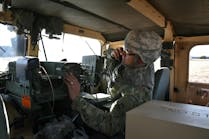By James A. Robles
ARLINGTON, Va. — Eight years after the Perry Memo initiated the latest round of acquisition reform, the avionics industry has made considerable progress incorporating commercial off-the-shelf (COTS) assemblies into systems. Despite the inherent challenges, our experience has shown that incorporation of COTS assemblies in avionics systems has tremendous performance and cost benefits given that the appropriate engineering and business practices are followed to assure the required affordability, performance, reliability, and availability are achieved.
To assist government agencies and industry in developing a consensus on the appropriate practices, and to assist in assuring that these practices are followed, the Government Electronics and Information Technology Association (GEIA) Avionics Process Management Committee (APMC) has developed EIA-933, a "Standard for Preparing a COTS Assembly Management Plan." The GEIA APMC solicited the participation of interested parties to conduce to the development of an optimum standard.
We have learned that COTS comes in many flavors: military non-developmental items (NDI); semi-custom development for avionics applications using commercial engineering and business practices; catalogue items from vendors targeting the military/ruggedized market; and catalogue items from vendors targeting the commercial market. COTS also comes in many grades: military/premium; industrial; and commercial. Each combination of flavor and grade comes with its own set of issues and challenges.
The more "truly" commercial is the assembly being considered, the greater are the challenges due to cultural differences between the vendor and integrator. As a result, some of the greatest challenges occur in those avionics applications where relatively benign environments allow the use of "truly" COTS products. Although the cost of COTS assemblies is substantially less than traditional customized avionics, the effort required to integrate COTS assemblies successfully is significantly greater.
It appears that the need to use COTS assemblies in avionics systems will continue to increase since recent studies indicate that the supply of militarized assemblies is following the same path previously followed by components (also called piece parts).
Establishing communication and a common understanding of best practices between suppliers of COTS assemblies, the integrators of avionics systems, regulators, and the users of these systems are required to optimize the use of COTS assemblies in avionics systems.
The GEIA APMC "Standard for Preparing a COTS Assembly Management Plan" supports this need. In this context avionics systems include electronics used in commercial, civil and military applications.
EIA-933 is intended to support these goals of acquisition reform:
- streamline and simplify the procurement process in order to reduce development and production cycle times as well as program costs; and
- strengthen the technology and industrial base through increased government access to, and use of, commercial items incorporating advanced technologies.
EIA-933 is supposed to support industry, customer, and regulatory agency needs and to make broadest possible use of proven industry standards.
EIA-933 was the logical outgrowth of ongoing GEIA APMC efforts. This committee is the U.S. Technical Advisory Group (TAG) to International Electrotechnical Commission Technical Committee 107 (IEC TC 107) "Process Management for Avionics."
GEIA has published two documents for use by suppliers of assemblies:
- ANSI/EIA-4899, Standard for Preparing an Electronic Components Management Plan; and
- ANSI/EIA-4900, Use of Semiconductor Devices Outside Manufacturers' Specified Temperature Ranges
The IEC has published two documents for use by the suppliers of assemblies which were derived from the GEIA documents:
- IEC/PAS 62239, Edition 1.0, 2001-04, Electronic Component Management Plans; and
- IEC/PAS 62240, Edition 1.0, 2001-04, Use of Semiconductor Devices Outside Manufactures Specified Temperature Ranges.
These "Publicly Available Standards," which will be published as International Standards within two years, represent the current commercial aviation practices of the member countries of IEC TC 107, and also of the member companies of the APMC. Leaders of the U.S. Department of Defense (DOD) participated in developing these documents and have "agreement in principle" with DOD that these documents are suitable for DOD programs.
EIA-933 was developed in accordance with these guidelines:
- it is unrealistic to try to define lists of assemblies that are always acceptable or, conversely, always unacceptable, in avionics applications;
- qualification, quality assurance, and reliability assurance;
- the process requirements should be based on industry consensus, and should be flexible enough to allow avionics integrators to implement them in ways that are most efficient for them, and effective for the customer
- there should be effective and efficient verification that the above process is implemented and maintained correctly.
The scope of the standard is to establish avionics integrator engineering and business practices that assure:
- assembles are applied properly in the design of the system;
- assemblies are fully qualified for the intended application;
- the quality of every individual assembly is assured in all required environments;
- assemblies are compatible with the integration process;
- processes are in place to collect, store, retrieve, analyze, and act upon data related to the assembly itself, and also relevant assembly data from avionics system design, integration, and assembly use in service;
- assemblies are selected, substituted, and managed systematically by the avionics integrator to maintain a traceable path to the qualified system through the operation of an effective configuration management system; and
- assembly availability, obsolescence, and reliability are understood, and their impacts on the application are understood and managed.
Avionics system suppliers will be able to use this standard to establish their baseline processes for COTS.
Companies or individuals who have an interest in participating in the committee or the continuing development of EIA-933, or related issues may contact one of the following:
1. Chris Denham ([email protected]), GEIA, Vice President Standards and Technology.
2. James A. Robles ([email protected]) convenor for the working group for EIA-933.
3. Lloyd Condra ([email protected]) chairman of the APMC.
For more information, contact the Government Electronics & Information Technology Association by phone at 703-907-7566, by fax at 703-907-7968, by post at 2500 Wilson Blvd., Arlington, Va. 22201-3834, or on the World Wide Web at http://www.geia.org/.
James A. Robles is with the Boeing Co. in Seattle.


